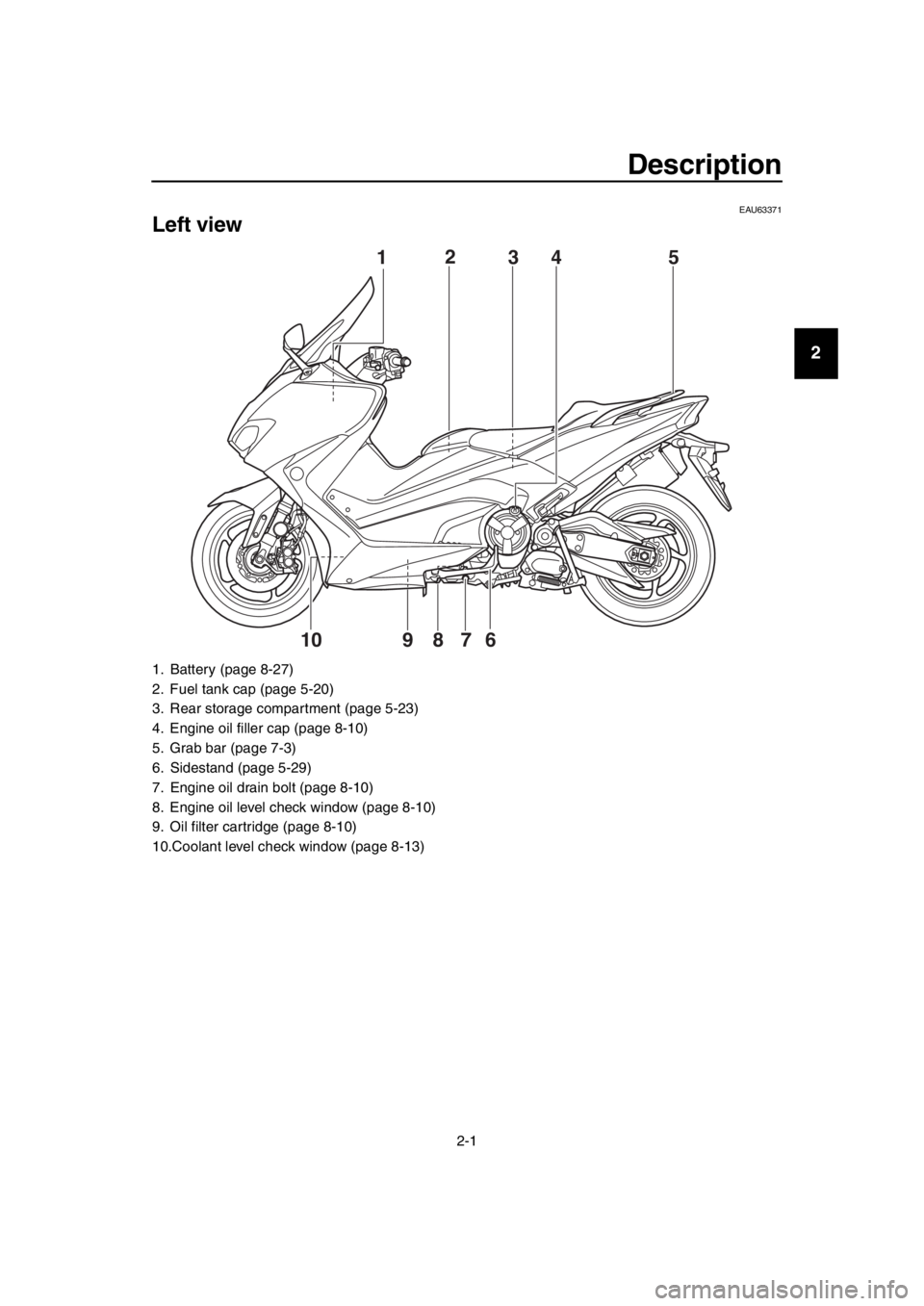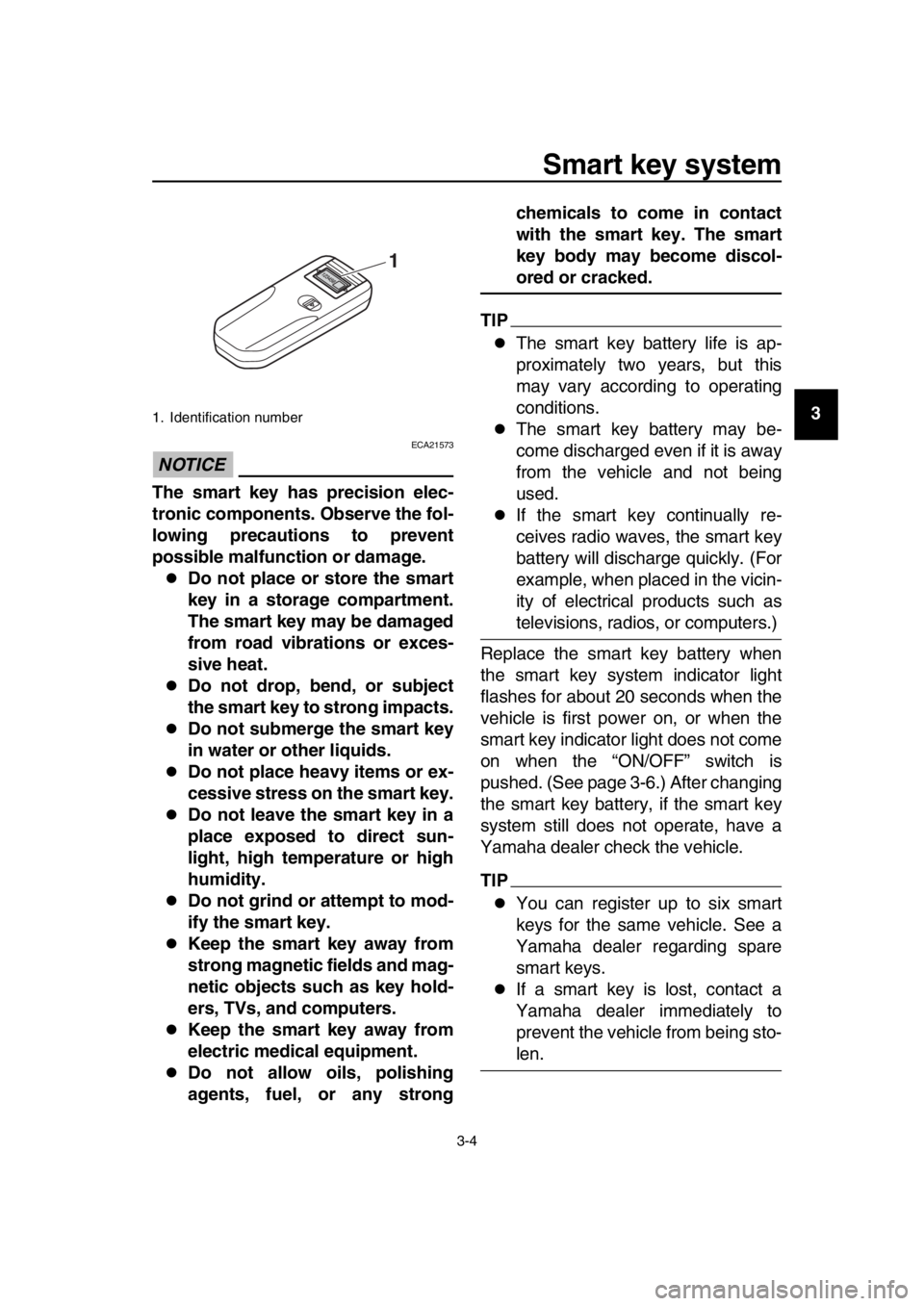YAMAHA TMAX 2018 User Guide
Manufacturer: YAMAHA, Model Year: 2018, Model line: TMAX, Model: YAMAHA TMAX 2018Pages: 122, PDF Size: 14.97 MB
Page 11 of 122

Safety information
1-4
1
2
3
4
5
6
7
8
9
10
11
12
13
14
position to test the products that these
aftermarket companies produce.
Therefore, Yamaha can neither en-
dorse nor recommend the use of ac-
cessories not sold by Yamaha or
modifications not specifically recom-
mended by Yamaha, even if sold and
installed by a Yamaha dealer.
Aftermarket Parts, Accessories,
and Modifications
While you may find aftermarket prod-
ucts similar in design and quality to
genuine Yamaha accessories, recog-
nize that some aftermarket accessories
or modifications are not suitable be-
cause of potential safety hazards to you
or others. Installing aftermarket prod-
ucts or having other modifications per-
formed to your vehicle that change any
of the vehicle’s design or operation
characteristics can put you and others
at greater risk of serious injury or death.
You are responsible for injuries related
to changes in the vehicle.
Keep the following guidelines in mind,
as well as those provided under “Load-
ing” when mounting accessories.
Never install accessories or carry
cargo that would impair the perfor-
mance of your scooter. Carefully
inspect the accessory before using
it to make sure that it does not in
any way reduce ground clearance
or cornering clearance, limit sus-
pension travel, steering travel or
control operation, or obscure lights
or reflectors.
Accessories fitted to the handle- bar or the front fork area can cre-
ate instability due to improper
weight distribution or aerody- namic changes. If accessories
are added to the handlebar or
front fork area, they must be as
lightweight as possible and
should be kept to a minimum.
Bulky or large accessories may seriously affect the stability of
the scooter due to aerodynamic
effects. Wind may attempt to lift
the scooter, or the scooter may
become unstable in cross
winds. These accessories may
also cause instability when
passing or being passed by
large vehicles.
Certain accessories can dis- place the operator from his or
her normal riding position. This
improper position limits the free-
dom of movement of the opera-
tor and may limit control ability,
therefore, such accessories are
not recommended.
Use caution when adding electrical
accessories. If electrical accesso-
ries exceed the capacity of the
scooter’s electrical system, an
electric failure could result, which
could cause a dangerous loss of
lights or engine power.
Aftermarket Tires and Rims
The tires and rims that came with your
scooter were designed to match the
performance capabilities and to provide
the best combination of handling, brak-
ing, and comfort. Other tires, rims, siz-
es, and combinations may not be
appropriate. Refer to page 8-17 for tire
specifications and more information on
replacing your tires.
UBV1E1_1.book 4 ページ 2018年4月27日 金曜日 午後4時41分
Page 12 of 122

Safety information
1-5
1
2
3
4
5
6
7
8
9
10
11
12
13
14 Transporting the Scooter
Be sure to observe following instruc-
tions before transporting the scooter in
another vehicle.Remove all loose items from the
scooter.
Point the front wheel straight
ahead on the trailer or in the truck
bed, and choke it in a rail to pre-
vent movement.
Secure the scooter with tie-downs
or suitable straps that are attached
to solid parts of the scooter, such
as the frame or upper front fork tri-
ple clamp (and not, for example, to
rubber-mounted handlebars or
turn signals, or parts that could
break). Choose the location for the
straps carefully so the straps will
not rub against painted surfaces
during transport.
The suspension should be com-
pressed somewhat by the tie-
downs, if possible, so that the
scooter will not bounce excessive-
ly during transport.
EAU57600
Further safe-riding points
Be sure to signal clearly when
making turns.
Braking can be extremely difficult
on a wet road. Avoid hard braking,
because the scooter could slide.
Apply the brakes slowly when
stopping on a wet surface.
Slow down as you approach a cor-
ner or turn. Once you have com-
pleted a turn, accelerate slowly.
Be careful when passing parked
cars. A driver might not see you
and open a door in your path.
Railroad crossings, streetcar rails,
iron plates on road construction
sites, and manhole covers be-
come extremely slippery when
wet. Slow down and cross them
with caution. Keep the scooter up-
right, otherwise it could slide out
from under you.
The brake pads or linings could get
wet when you wash the scooter.
After washing the scooter, check
the brakes before riding.
Always wear a helmet, gloves,
trousers (tapered around the cuff
and ankle so they do not flap), and
a brightly colored jacket.
Do not carry too much luggage on
the scooter. An overloaded scoot-
er is unstable. Use a strong cord to
secure any luggage to the carrier
(if equipped). A loose load will af-
fect the stability of the scooter and
could divert your attention from the
road. (See page 1-3.)
UBV1E1_1.book 5 ページ 2018年4月27日 金曜日 午後4時41分
Page 13 of 122

2-1
1
2
3
4
5
6
7
8
9
10
11
12
13
14
Description
EAU63371
Left view
1. Battery (page 8-27)
2. Fuel tank cap (page 5-20)
3. Rear storage compartment (page 5-23)
4. Engine oil filler cap (page 8-10)
5. Grab bar (page 7-3)
6. Sidestand (page 5-29)
7. Engine oil drain bolt (page 8-10)
8. Engine oil level check window (page 8-10)
9. Oil filter cartridge (page 8-10)
10.Coolant level check window (page 8-13)
1 2
34 5
976 8
10
UBV1E1_1.book 1 ページ 2018年4月27日 金曜日 午後4時41分
Page 14 of 122

Description
2-2
1
2
3
4
5
6
7
8
9
10
11
12
13
14
EAU63391
Right view
1. Owner’s tool kit (page 8-2)
2. Air filter element (page 8-14)
3. Windshield (page 5-25/5-8)
4. Fuses (page 8-28)
5. Centerstand (page 8-25)
1 2
34
5
UBV1E1_1.book 2 ページ 2018年4月27日 金曜日 午後4時41分
Page 15 of 122

Description
2-3
1
2
3
4
5
6
7
8
9
10
11
12
13
14
EAU63401
Controls and instruments
1. Rear brake lever (page 5-18)
2. Left handlebar switches (page 5-1)
3. Rear brake lock lever (page 5-18)
4. Speedometer (page 5-4)
5. Multi-function display (page 5-5)
6. Tachometer (page 5-5)
7. Right handlebar switches (page 5-1)
8. Front brake lever (page 5-17)
9. Throttle grip (page 8-16)
10.Front storage compartment (page 5-23)
11.Auxiliary DC jack (page 5-28)
12.Smart key system switches (page 3-1)
1 23456 7 8
10, 11
12
12
9
UBV1E1_1.book 3 ページ 2018年4月27日 金曜日 午後4時41分
Page 16 of 122

3-1
1
2
3
4
5
6
7
8
9
10
11
12
13
14
Smart key system
EAU77201
Smart key system
The smart key system enables the ve-
hicle to be operated without using a
mechanical key.
WARNING
EWA14704
Keep implanted pacemakers or
cardiac defibrillators, as well as
other electric medical devices
away from the vehicle mounted
antenna (see illustration).
Radio waves transmitted by the
antenna may affect the opera-
tion of such devices when close
by.
If you have an electric medical
device, consult a doctor or the
device manufacturer before us-
ing this vehicle.
In addition to the vehicle mounted an-
tenna, the smart key system consists of
the smart key, smart key system indica-
tor light, “ON/ ” switch, and the
“OFF/LOCK” and “ / ” switches.
1. Vehicle mounted antenna
1
1. Smart key
1. Smart key system indicator light “ ”
1. “ON/ ” switch
1
1
1
UBV1E1_1.book 1 ページ 2018年4月27日 金曜日 午後4時41分
Page 17 of 122

Smart key system
3-2
1
2
3
4
5
6
7
8
9
10
11
12
13
14
NOTICE
ECA15764
The smart key system uses weak ra-
dio waves. The smart key system
may not work in the following situa-
tions.
The smart key is placed in a lo-
cation exposed to strong radio
waves or other electromagnetic
noise
There are facilities nearby that
are emitting strong radio waves
(TV or radio towers, power
plants, broadcasting stations,
airports, etc.)
You are carrying or using com-
munication equipment such as
radios or mobile phones in
close proximity of the smart key
The smart key is in contact with
or covered by a metallic object
Other vehicles equipped with a
smart key system are nearby
In such situations, move the smart
key to another location and perform
the operation again. If it still does
not work, use the mechanical key to
carry out the operation in emergen-
cy mode. (See page 8-36.)
EAU77213
Operating range of the smart
key system
The operating range of the smart key
system is about 80 cm (31.5 in) from
the center of the handlebars.
TIP
As the smart key system uses
weak radio waves, the operating
range may be affected by the sur-
rounding environment.
When the battery of the smart key
is discharged, the smart key may
not work or its operating range be-
come very small.
If the smart key is turned off, the
vehicle will not recognize the smart
key even if it is within operating
range.
If the “ON/ ” switch, “OFF/LOCK”
switch, or “ / ” switch are re-
peatedly pressed when the smart
key is out of range or cannot com-
1. “ / ” switch
2. “OFF/LOCK” switch
12
UBV1E1_1.book 2 ページ 2018年4月27日 金曜日 午後4時41分
Page 18 of 122

Smart key system
3-3
1
2
3
4
5
6
7
8
9
10
11
12
13
14 municate with the vehicle, all
switches will be temporarily dis-
abled.
Placing the smart key in the front
or rear storage compartment may
block communication between the
smart key and the vehicle. If the
rear trunk or front storage com-
partment is locked with the smart
key inside, the smart key system
may be disabled. The smart key
should always carried on your per-
son.
WARNING
EWA17952
The smart key should be carried
with you. Do not store it on the
vehicle.
When the smart key is within op-
erating range, exercise due care
because other people not carry-
ing the smart key can start the
engine and operate the vehicle.
EAU61646
Handling of the smart key and
mechanical key
Included with the vehicle is one smart
key (with a built-in mechanical key) and
one spare mechanical key with an iden-
tification card. Keep the spare mechan-
ical key and card separate from the
smart key. Should you lose or damage
the smart key, or when its battery is dis-
charged, the mechanical key will serve
as a back up. The seat can be opened,
the smart key system identification
number can be manually input, and
then the vehicle can be operated. (See
page 8-36.) We recommend that you
note down the identification number
in case of emergency.
If the smart key and identification card
of the mechanical key are both lost or
damaged, and there is no record of the
identification number, the entire smart
key system will need to be replaced.
TIP
The identification number can also be
found on the smart key itself.
1. Smart key
2. Mechanical key
3. Identification number card
1234
56
123
UBV1E1_1.book 3 ページ 2018年4月27日 金曜日 午後4時41分
Page 19 of 122

Smart key system
3-4
1
2
3
4
5
6
7
8
9
10
11
12
13
14
NOTICE
ECA21573
The smart key has precision elec-
tronic components. Observe the fol-
lowing precautions to prevent
possible malfunction or damage.
Do not place or store the smart
key in a storage compartment.
The smart key may be damaged
from road vibrations or exces-
sive heat.
Do not drop, bend, or subject
the smart key to strong impacts.
Do not submerge the smart key
in water or other liquids.
Do not place heavy items or ex-
cessive stress on the smart key.
Do not leave the smart key in a
place exposed to direct sun-
light, high temperature or high
humidity.
Do not grind or attempt to mod-
ify the smart key.
Keep the smart key away from
strong magnetic fields and mag-
netic objects such as key hold-
ers, TVs, and computers.
Keep the smart key away from
electric medical equipment.
Do not allow oils, polishing
agents, fuel, or any strong chemicals to come in contact
with the smart key. The smart
key body may become discol-
ored or cracked.
TIP
The smart key battery life is ap-
proximately two years, but this
may vary according to operating
conditions.
The smart key battery may be-
come discharged even if it is away
from the vehicle and not being
used.
If the smart key continually re-
ceives radio waves, the smart key
battery will discharge quickly. (For
example, when placed in the vicin-
ity of electrical products such as
televisions, radios, or computers.)
Replace the smart key battery when
the smart key system indicator light
flashes for about 20 seconds when the
vehicle is first power on, or when the
smart key indicator light does not come
on when the “ON/OFF” switch is
pushed. (See page 3-6.) After changing
the smart key battery, if the smart key
system still does not operate, have a
Yamaha dealer check the vehicle.
TIP
You can register up to six smart
keys for the same vehicle. See a
Yamaha dealer regarding spare
smart keys.
If a smart key is lost, contact a
Yamaha dealer immediately to
prevent the vehicle from being sto-
len.
1. Identification number
1
UBV1E1_1.book 4 ページ 2018年4月27日 金曜日 午後4時41分
Page 20 of 122

Smart key system
3-5
1
2
3
4
5
6
7
8
9
10
11
12
13
14
EAU77223
Smart key
When the smart key is turned on and
brought within range, the smart key
system allows you to operate the vehi-
cle without inserting a mechanical key.
If the smart key is turned off, the vehicle
cannot be operated even if the smart
key is within operating range of the ve-
hicle.
The current status of the key can be
checked by briefly pressing the
“ON/OFF” switch.
Short flash: the key is on
Long flash: the key is off
To turn the smart key on or off
To turn the smart key on or off, press
the “ON/OFF” switch for one second.
The smart key indicator light will flash. If
the key does a short flash, the key is on.
If the key does a long flash, the key is
off.
TIP
To preserve the vehicle battery power,
the smart key system will turn off auto-
matically about a week after the vehicle
is last used. In this case, press the
“ON/ ” switch once to turn on the smart key system, and then once more
to turn on the vehicle power.
To use the mechanical key
Pull out the mechanical key from the
smart key body. After using the me-
chanical key, insert it back into the
smart key.
1. “ON/OFF” switch
2. Smart key indicator light
3. Mechanical key
1
2
3
UBV1E1_1.book 5 ページ 2018年4月27日 金曜日 午後4時41分